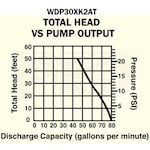Local Pickup FAQ's

Hover to zoom
1 Of 5
+
Share This Product
Recommended Accessories
Expert Recommended Accessories
Selected by Jim, our Expert
Required Accessories
9
These accessories are required to properly setup/install this product.
Optional Accessories
10
Features
Inlet Size
3 Inch
Style
Diaphragm
GPM
80 Gallons
Engine
Honda GX
- Heavy-Duty 3" Diaphragm Pump
- Suited for muddy water, sludge or any water w/ high solid content
- Commercial Grade 118cc Honda OHV GX120 4-Cycle Engine
- Provides excellent torque & fuel efficiency
- Protected By Honda Oil Alert® Warning System
- Alerts you or shuts engine down if oil reaches an unsafe level
- Helps to prevent engine seizure due to a low oil condition
- Die-Cast Aluminum Case, Air Cushion Chamber & "Rock Channel"
- Prevents case damage & allows this pump to easily pass solids
- Rugged Neoprene Diaphragm w/ Nylon Insert
- Provides the ability to pass solids up to 2.4"
- "Run Dry" Design
- Perfect when low volume, run dry operation is required
- Stand Wheel Kit & Handle
- Makes this pump easy to move around
- Heavy Duty Frame
- Provides a sturdy base for the motor and pump
- EPA Approved & CARB Compliant
- 3-Year Residential & Commercial Warranty
California residents see
Warning: This product can expose you to chemicals including Carbon monoxide which is known to the State of California to cause Developmental Harm, and Soots, tars, and mineral oils (untreated and mildly treated oils and used engine oils) which is known to the State of California to cause Cancer.
For more information go to: www.p65Warnings.ca.gov
Specifications
WDP30XK2AT

General Information
Product Category
Water Pump
Pump
Gallons Per Minute
80 Gallons
Inlet Diameter
3 Inch
Outlet Diameter
3 Inch
Self Priming
Yes
Pump Head Material
Aluminum
Pump Housing Drain
No
Quick Clean Out
No
Solids Handling Size
2.4 inch
Suction Head
24 Feet
Total Head Lift
50 Feet
Submersible
No
Engine
Engine Brand
Honda GX
Starting System
Recoil Start
Engine Cycles
4-Cycle
Low Oil Shutdown
Yes
Continuous Operation
Yes
CC
118 cc
Fuel Tank Size
0.525 Gallons
Consumer Engine Warranty
3 Years
Commercial Engine Warranty
3 Years
Overview
Product Category
Water Pump
Weight
163 Pounds
Made in USA
No
Consumer Warranty
3 Years
Product Length
31.5 Inches
Product Width
30.5 Inches
Product Height
25.7 Inches
UPC
786102002486
Additional Model Numbers
WDP30, WDP30XK2AT
Accessories
Tool Kit
No
Strainer
Yes
Hose Couplings
No
Hose
Sold Separately
Hose Bands
No
Lifting Hook
Yes
Wheel Kit
Yes
Reviews
(4)
Honda WDP30XK2AT Reviews & Ratings
Product Q&A
(2)
Product Questions
Answered by Jim, the Water Pump Expert
At 40 gpm what is the psi rating for the Honda WDP30XK1AT 3" pump?
Adesco
from Nevada
June 02, 2014
I am in the plumbing business and maintain a water district, so I am looking for a diaphragm pump that is best suited for fixing leaks when the water can't be shut off. I am looking at Honda WDP30XK1AT and the Subaru PTX301D. There isn't much price difference, so which do you suggest? Overall, I am looking for a pump that will stand up to the abuse over the years and has replacement parts readily available if needed. Thanks
Adrian Briles
from Kansas
January 27, 2014
How-To Articles
How to Pick the Perfect Gas Water Pump
If you need to know how to move a lot of water FAST,you're reading the right pa...
What to Do Before, During, and After a Flood
Flooding is scary. It can happen anytime, anywhere, and causes damage without d...
How to Pick the Perfect Dewatering Pump
Basements, yards, and construction sitescan all flood, but with the help of a d...
Manuals
Ask A Question!
*Required Fields
+
 Thank You For Submitting Your Question
Your submission has been sent successfully. Please give our experts up to two business days to respond.
Thank You For Submitting Your Question
Your submission has been sent successfully. Please give our experts up to two business days to respond.

Media Gallery
Honda WDP30XK1AT - 80 GPM (3") Diaphragm Water Pump




Customer Review Images








